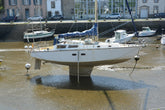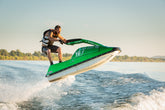Are you ready to embark on an exhilarating journey into the world of boating? Imagine gliding across the sparkling waters, the wind caressing your face, and the vast expanse of the open sea or lake stretching before you. Boating is more than just a leisurely activity; it's a way to connect with nature, escape the hustle and bustle of daily life, and create cherished memories with loved ones.
The importance of learning how to drive a boat
While boating can be an incredibly rewarding experience, it's crucial to understand the significance of learning how to drive a boat safely and responsibly. Mastering the art of boat operation not only ensures your safety but also protects the well-being of your passengers and fellow boaters. By acquiring the necessary skills, you'll gain confidence and peace of mind, allowing you to fully immerse yourself in the joys of boating.
Understanding the basics of boat operation
Before we dive into the step-by-step guide, let's explore the fundamental principles of boat operation. First and foremost, familiarize yourself with the various parts of a boat and their functions. From the helm to the propulsion system, understanding the components will help you navigate with ease.
Next, grasp the concept of buoyancy and how it affects your vessel's stability. Knowing the factors that influence a boat's balance will enable you to make informed decisions and maintain control in different situations.
Preparing for a boat trip
Proper preparation is key to a successful and enjoyable boating adventure. Before setting sail, ensure you have all the necessary equipment on board, such as life jackets, flares, and a first-aid kit. Additionally, check the weather forecast and plan your route accordingly. Familiarize yourself with the local regulations and obtain any required permits or licenses.
Safety precautions when driving a boat
Safety should always be your top priority when operating a boat. Familiarize yourself with the rules of the waterway and follow them diligently. Maintain a safe speed and be aware of your surroundings at all times. Never operate a boat under the influence of alcohol or drugs, and always have a designated sober operator.
Step-by-step guide to driving a boat
-
Pre-Departure Checks: Before starting the engine, conduct a thorough inspection of the boat and its components. Check the fuel level, oil, and battery, and ensure all safety equipment is on board and in working order.
-
Starting the Engine: Follow the manufacturer's instructions for starting the engine. Engage the neutral gear and allow the engine to warm up before proceeding.
-
Casting Off: Untie the lines securing the boat to the dock or mooring. Have a crew member assist you if necessary.
-
Steering and Throttle Control: Familiarize yourself with the steering wheel or tiller and the throttle controls. Understand how to engage forward and reverse gears smoothly.
-
Leaving the Dock: When departing the dock, use the appropriate combination of forward and reverse gears, along with the steering, to maneuver the boat away from the dock safely.
-
Maintaining a Proper Lookout: Keep a vigilant watch for other vessels, obstacles, and navigational aids while underway.
-
Adjusting Speed and Direction: Use the throttle and steering controls to adjust your speed and direction as needed, taking into account factors such as wind, currents, and boat traffic.
-
Turning and Maneuvering: Practice turning techniques, such as the pivot turn and the gradual turn, to gain confidence in maneuvering your boat.
-
Docking and Anchoring: When approaching a dock or anchoring spot, reduce your speed and plan your approach carefully. Use the appropriate combination of forward and reverse gears, along with the steering, to maneuver the boat into position.
-
Securing the Boat: Once docked or anchored, secure the boat properly by tying it up or setting the anchor correctly.
Maneuvering techniques and tips
Mastering maneuvering techniques is crucial for safe and efficient boat operation. Practice techniques such as trimming the boat for optimal performance, executing tight turns, and navigating through narrow channels or crowded waterways. Additionally, learn how to handle the boat in various conditions, such as strong winds or choppy waters.
Navigating different weather conditions
Weather can have a significant impact on boating conditions. Familiarize yourself with reading weather reports and understanding how different weather patterns can affect your vessel's performance and safety. Learn how to adapt your boating techniques to handle conditions such as high winds, rain, fog, or thunderstorms.
Docking and anchoring a boat
Docking and anchoring are essential skills for any boater. Practice docking techniques, such as approaching the dock at the correct angle and speed, and using fenders and lines effectively. When anchoring, learn how to select a suitable anchoring spot, set the anchor correctly, and maintain the proper scope of the anchor line.
Boat maintenance and care
Proper maintenance and care are crucial for ensuring the longevity and safe operation of your boat. Develop a routine for inspecting and servicing various components, such as the engine, electrical systems, and hull. Additionally, learn how to properly clean and store your boat to protect it from the elements.
Resources for further learning and certification
Continuous learning and certification are essential for responsible boating. Explore various resources, such as boating courses, online tutorials, and local boating clubs, to enhance your knowledge and stay up-to-date with regulations and best practices. Consider obtaining boating licenses or certifications to demonstrate your commitment to safety and responsible operation.
Conclusion
Congratulations! You've embarked on an exciting journey to becoming a skilled and confident boat operator. Remember, boating is not just a pastime; it's a way of life that combines adventure, relaxation, and a deep appreciation for nature. By following the steps outlined in this guide, practicing regularly, and prioritizing safety, you'll be well on your way to creating unforgettable memories on the water.


![Veratron OL 43 Smart Marine Monitoring TFT Display [B00126101]](http://arcmarine.co/cdn/shop/files/111172XL_165x.jpg?v=1763678982)
![Veratron Suzuki VMH-35 PWM Display w/Sumitomo Connectors [B00204101]](http://arcmarine.co/cdn/shop/files/111170XL_165x.jpg?v=1763678982)



